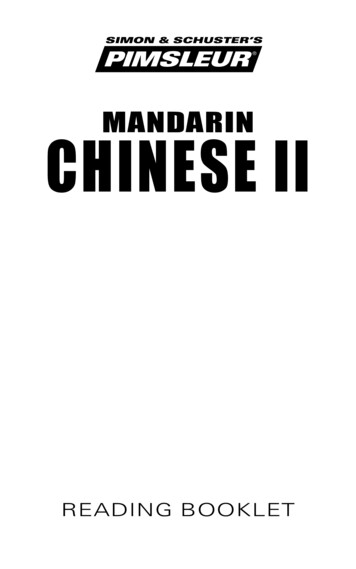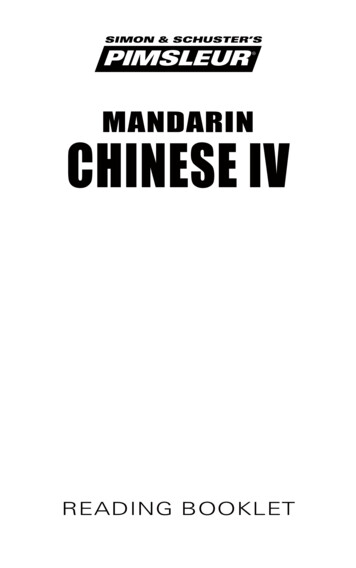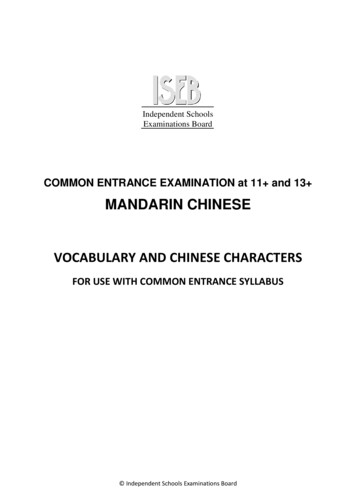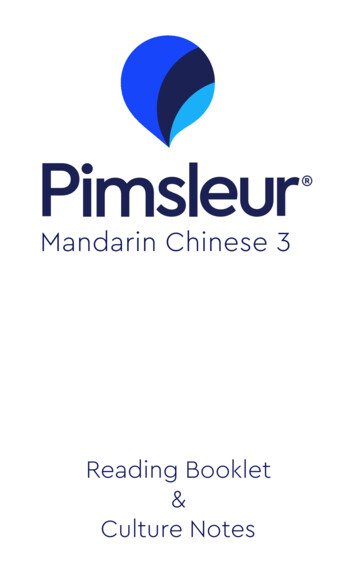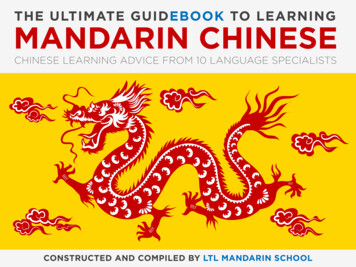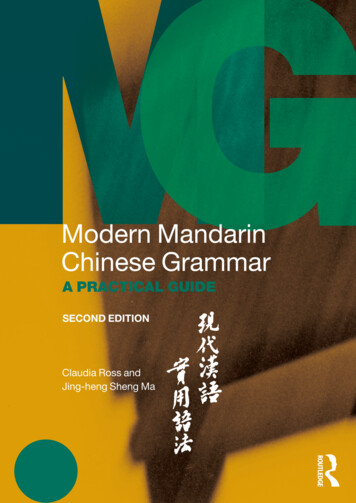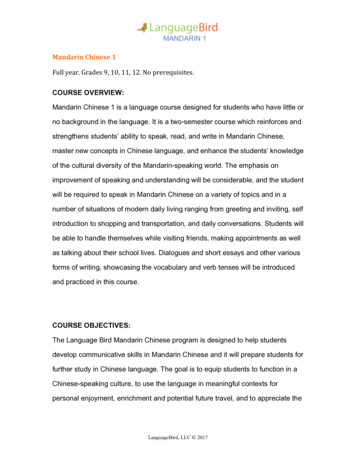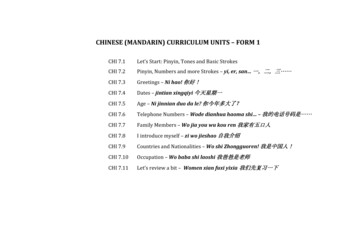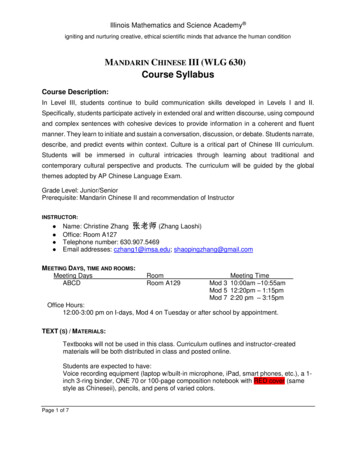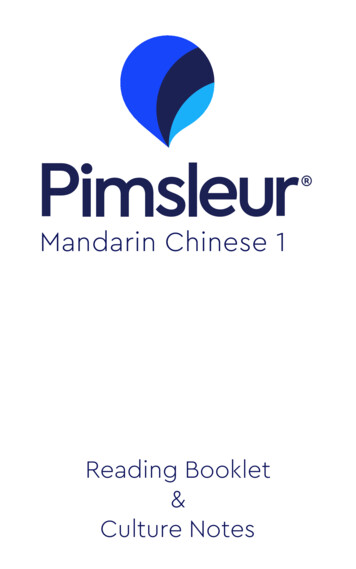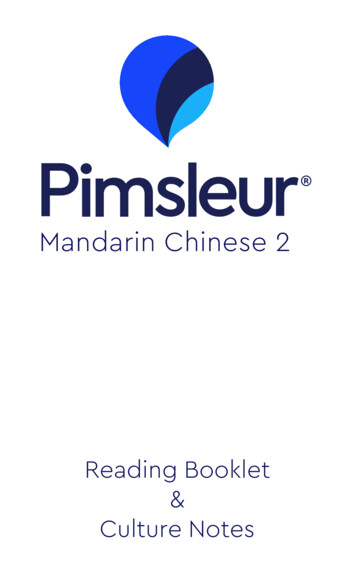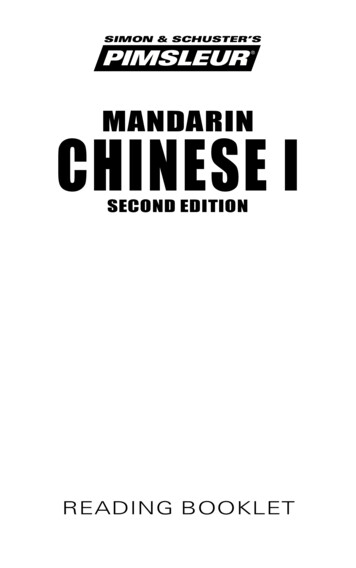
Transcription
SIMON & SCHUSTER’SPIMSLEUR MANDARINchinese Isecond editionreading booklet
Travelers should always check with theirnation's State Department for currentadvisories on local conditions beforetraveling abroad.Graphic Design: Maia Kennedy and ‰ Recorded Program 2000 Simon & Schuster, Inc. Reading Booklet 2000 Simon & Schuster, Inc.Pimsleur is an imprint of Simon & Schuster Audio,a division of Simon & Schuster, Inc. Mfg. in USA.All rights reserved.
ACKNOWLEDGMENTSMANDARIN CHINESE Isecond editionVoicesEnglish-Speaking Instructor . . . . . . . . . . . Ray BrownMandarin-Speaking Instructor . . . . . . . . . . Zhijie JiaFemale Mandarin Speaker . . . . . . . . . Mei Ling DiepMale Mandarin Speaker . . . . . . . . . . . . . . Yaohua ShiCourse WritersMei Ling Diep Christopher J. GaintyEditorsKimiko Ise Abramoff Beverly D. HeinleDirectorEdith ShillueExecutive ProducerBeverly D. HeinleProducerSarah H. McInnisRecording EngineersPeter S. Turpin Kelly SauxSimon & Schuster Studios, Concord, MAiii
For more information, call1-800-831-5497 or visit us atwww.Pimsleur.com
table of contentsNotesThe Mandarin Language . . . . . . . . . . . . . . . . . . . 1The Written System . . . . . . . . . . . . . . . . . . 3Traditional and Simplified Script . . . . . . . . . 4Tonality . . . . . . . . . . . . . . . . . . . . . . . . . . . . 5Tone Change . . . . . . . . . . . . . . . . . . 7Traditional Language Beliefs . . . . . . . . . . . . . . . 9Color Symbolism . . . . . . . . . . . . . . . . . . . . . . . . 11Names and Titles . . . . . . . . . . . . . . . . . . . . . . . . . 12The Concept of mian zi (“face”) . . . . . . . . . . . . . 14Compliments . . . . . . . . . . . . . . . . . . . . . . . . . . . 15Chinese Cuisine and Tea . . . . . . . . . . . . . . . . . . . 16The Chinese Zodiac . . . . . . . . . . . . . . . . . . . . . . . 17Hospitality . . . . . . . . . . . . . . . . . . . . . . . . . . . . . . 21Chinese Festivals . . . . . . . . . . . . . . . . . . . . . . . . . 24Proverbs . . . . . . . . . . . . . . . . . . . . . . . . . . . . . . . 27Measure Words . . . . . . . . . . . . . . . . . . . . . . . . . . 31Questions. . . . . . . . . . . . . . . . . . . . . . . . . . . . . . . 32Climate . . . . . . . . . . . . . . . . . . . . . . . . . . . . . . . . 32Currency / Transportation / Communication . . . . . 33Education . . . . . . . . . . . . . . . . . . . . . . . . . . . . . . 34v
MANDARIN IThe Mandarin LanguageLearning any language is enhanced by someknowledge of the cultural customs and beliefs of itsnative speakers. Developing an awareness of and asensitivity to a language’s subtleties are inherent toacquiring true fluency. The following “Notes” forPimsleur’s Mandarin Chinese I are meant to provideyou with an introduction as to how the language andthe culture are intertwined.Mandarin Chinese is the state language ofChina, used by the government and in the schools.Although there are eight major Chinese dialects,Mandarin is native to approximately seventyper-cent of the population and is the only dialect thathas a corresponding written form of the language.Chinese who are educated through at least theprimary grades speak Mandarin as well as localdialects. However, due to the size of China and theethnic diversity of its inhabitants, hundreds of otherdialects are spoken in different areas. The dialectsspoken today are based more on geography than onethnicity. For instance, residents of Shanghai willspeak Wu. In some parts of China, particularly thecentral and southern areas, education and officialbusiness are transacted in the locally dominant
MANDARIN IThe Mandarin Language (continued)language. Although people from different parts ofChina generally do not understand one another’sspoken language, they use the same basic set ofcharacters for writing.Today’s Mandarin is closely based on “northernspeech” which was the lingua franca of the rulingclass, spoken in Beijing, the capital during theMing and Qing Dynasties. After the Nationalistsoverthrew the Qing Dynasty in 1912, governmentofficials at first considered creating a new “nationallanguage” by adopting a mixture of dialects, but in theend it was decided to retain Mandarin as the “NationalLanguage.” The Communists, who defeated theNationalists in 1949, continued this policy, but theychanged the name and coined the term putonghuaor “common speech” for “Mandarin.” This is theword for Mandarin used throughout mainlandChina. In Hong Kong, however, as in Taiwan andmost overseas communities, guo yu, the older term,continues to be used.Pronunciation of the national languagediffers slightly geographically. The Nationalists,whose capital was the southern city of Nanjing,2
MANDARIN IThe Mandarin Language (continued)were influenced by southern dialects, primarilyCantonese. The Communists, whose capital isBeijing, were influenced by “northern speech.”The Written SystemIt is commonly thought that every Chinesecharacter is a picture, or “pictograph,” but only a fewhundred of the several thousand characters are truepictographs. However, most of these are now writtenin such a way that it is difficult to immediately guesstheir meaning. There is also a very small group ofcharacters called “ideographs” or “ideograms,”which represent ideas or objects directly. All otherChinese characters are combinations of thesepictographs and basic ideographs.3
MANDARIN IThe Mandarin Language (continued)Traditional and Simplified ScriptIn 1949 China’s new government consideredinstituting an alphabet in place of the traditionalcharacters, as a refutation of traditional or “feudal”culture. Instead, they decided to “simplify” theexisting characters by reducing the number ofstrokes necessary to create them. By 1964, a listof 2,200 simplified characters was created for useas a “modified script.” Further simplification wasbriefly adopted, then abandoned, at the end of theCultural Revolution in 1977.Presently, simplified characters are used inmainland China and Singapore, although there isa movement for the restoration of traditional characters, especially in southern China. Hong Kong,Taiwan, and most overseas Chinese communitiescontinue to use the traditional characters.4
MANDARIN IThe Mandarin Language (continued)TonalityChinese is a “tonal” language. This means that inaddition to the sounds of the consonants and vowels,the tone with which a syllable is pronounced helpsto determine its meaning. The Chinese languagesare almost exclusively made up of one-syllablewords, composed of an initial consonant soundfollowed by the syllable’s main vowel, sometimesin combination with another consonant or vowel.Longer words do exist, but almost all are compoundwords, formed by combining one-syllable words.In order to convey meaning, Mandarin alsotakes into account the tone with which a syllableis pronounced. The tone is determined by thepronunciation of the syllable’s main vowel. Eachtone has a name which describes the falling or risingmotion. In this way, several meanings can be assignedto any one syllable, depending on the tone with whichit is pronounced. For example, when pronouncedusing a falling-rising tone, the word nar means“where.” However, when this word is pronouncedwith just a falling tone, it means “there.”5
MANDARIN IThe Mandarin Language (continued)There are four basic tones used in speakingMandarin: high, mid-rising, falling-rising, andfalling. In addition, there is a “soft” sound which isused for the second syllable in a set of doubled characters, as well as for the final syllable (or questionword) at the end of a query. For example, in the questions, ni ne? (How about you?) and hao ma? (OK?)the syllables ne and ma are pronounced using thissoft, falling sound, as if the sound is fading away.Here is an example of one sound with several different meanings, depending on the tone with whichit is pronounced:1st toneHighshi (“poem”)2nd toneRising / Mid-risingshi (“ten” or “time”)3rd tone4th toneFalling-rising Fallingshi (“history”)shi (all the forms of “to be”)6
MANDARIN IThe Mandarin Language (continued)Tone Change in MandarinAlthough each Chinese syllable standing alonehas a specific tone, in the flow of speech the toneof a syllable can change depending on the tone ofthe following syllable. This is called bian diao,“tone change,” and it alters both the sound and themeaning of certain words. In some Chinese dialects,tone change is common, and there are complex rulesgoverning it. In contemporary Mandarin, however,it is less common than in other dialects, and there areonly a few rules regarding tone change to remember.The first rule governs falling-rising (3rd) tones whenthey are spoken in sequence:1. When two falling-rising (3rd) tones occurtogether, the first falling-rising tone becomes arising or mid-rising (2nd) tone. The second remains afalling-rising (3rd) tone.For example, hen and hao are both falling-rising(3rd) tones by themselves, but when spoken togetheras hen hao the first word, hen, changes to a rising(2nd) tone, while the second, hao, keeps its originalfalling-rising (3rd) tone.7
MANDARIN IThe Mandarin Language (continued)2. When three falling-rising tones are spokenone after the other, the first two become rising (2nd)tones, while the third remains a falling-rising tone.3. When four falling-rising tones occur one afterthe other, the first three change from falling-risingtones to rising (2nd) tones, while the fourth remains afalling-rising (3rd) tone.In contemporary Mandarin, tone change is alsoassociated with two specific characters. The first ofthese is yi (00 ).1. Yi is a high level (1st) tone when it is by itselfor at the end of a word.2. When yi comes before a falling (4th) tone, itchanges to a rising (2nd) tone.3. When yi comes before any of the threeremaining tones (high, rising, or falling-rising), itchanges to a falling (4th) tone.The second character associated with tone changein contemporary Mandarin is bu (00 ).8
MANDARIN IThe Mandarin Language (continued)1. When bu stands alone, it is a falling (4th)tone.2. Bu changes tone in only one combination.When it comes before another falling (4th) tone, itchanges to a rising (2nd) tone.3. When combined with all the other tones, buremains a falling tone.Traditional Language BeliefsJust as the number thirteen is traditionallyregarded as unlucky in the West, the Chinese numberfour, si, is seen as ominous, because it is very similarto the pronunciation of the word for “death.” The onlydifference in this case is that “four,” si, is pronouncedwith a falling tone, while the word for “death,” si, ispronounced with a tone that falls and rises again.Conversely, the number eight, ba, is regarded aslucky, since it shares the same ending sound with thecharacter meaning “to prosper,” fa. In Cantonese,the mathematical form of the number two, yi, isconsidered lucky because it is pronounced the sameas the word for “easy,” yi. Although the Mandarin9
MANDARIN ITraditional Language Beliefs (continued)word for “two,” er, does not share the samepronunciation as the Mandarin word for “easy,” yi,speakers of Mandarin still believe the number two tobe good luck.The number nine, jiu, carries a positive meaningas this word sounds exactly like the Chinese wordmeaning “long-lasting,” jiu. These two words arerepresented in writing by two different characters,but when spoken, the distinction is made onlythrough context.The number “nine” is used in the city nameKowloon, jiu long, or literally, “nine dragons.” InChina, the dragon is a symbol of royalty and goodfortune. This number is also traditionally used whensetting a woman’s dowry. In contemporary China,this price is largely symbolic, and therefore theamount chosen is significant not for its size, but for thenumbers used to describe it. For that reason, the pricewill be set, for example, at “ninety-nine dollars” ratherthan “one hundred,” as the repetition of this number isthought to ensure longevity in the marriage.10
MANDARIN IColor SymbolismColors tend to be associated with differentmeanings in different cultures. It’s often useful tobe aware of these different connotations.In Chinese culture, the color red traditionallyimplies good fortune or good cheer. It is customaryto use this color when decorating for such traditionaloccasions as the celebration of a wedding or a birth.For this reason, brides wear red, babies are clad inred, and red is used most often when decorating forthe annual festivals. However, in today’s China,many people are adopting more typically Westernstyles of dress. For instance, many brides are combining Eastern and Western traditions, choosing towear a white gown to the wedding ceremony, andthen changing into a traditional red gown for thewedding banquet.The color green symbolizes youth and nature.However, one must never give a man a green hat orcap as a gift, as “to give a green hat” may imply thatone is committing adultery with the recipient’s wife.11
MANDARIN IColor Symbolism (continued)In the West, the prevalent color seen at a funeralis black. This color implies “ominous” in Chinese,and it may indeed be seen at funerals in China, butthe main color seen at funerals is white, the Chinesecolor of mourning.Names and TitlesAs in many other Asian cultures, in China thesociety or group is valued more highly than theindividual. Your importance is measured by yourvalue to the group, rather than by those qualitieswhich distinguish you from others.This can be seen in the way a person is namedin Chinese. The most important element of theperson’s name is thought to be the family of whichhe or she is a member, and so the family name isspoken first. The given name, which sets theperson apart even from others within the samefamily, is the final element. For example, in thename wang zhuo hua, wang is the family name,or surname, and zhuo hua the given name. Somesurnames have a specific meaning: wang, avery common Chinese surname, means “king.”12
MANDARIN INames
Pimsleur’s Mandarin Chinese I are meant to provide you with an introduction as to how the language and the culture are intertwined. Mandarin Chinese is the state language of China, used by the government and in the schools. Although there are eight major Chinese dialects, Mandarin is native to approximately seventy per-cent of the population and is the only dialect that has a corresponding .
